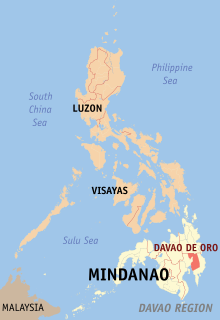| Kampalili moss mouse | |
|---|---|
| Scientific classification | |
| Domain: | Eukaryota |
| Kingdom: | Animalia |
| Phylum: | Chordata |
| Class: | Mammalia |
| Order: | Rodentia |
| Family: | Muridae |
| Genus: | Tarsomys |
| Species: | T. orientalis |
| Binomial name | |
| Tarsomys orientalis Rickart, Rowsey, Ibañez, Quidlat, Balete, & Heaney, 2024 | |

| |
| Distribution of T. orientalis in Mindanao, Philippines | |
The Kampalili moss mouse (Tarsomys orientalis), also known as the Kampalili tarsomys, is a species of rodent in the family Muridae. At just 5 in (130 mm) long, it is the smallest species of the Mindanao-endemic genus Tarsomys, and the third to be discovered. The species was distinguished from the other members of its genus, namely Tarsomys apoensis and T. echinatus, by the smaller size of its body, significantly shorter tail, smaller size of hind feet, the soft and dense pelage that is darker in color, its smaller skull that has a broader zygomatic plate, shorter incisive foramina, and much longer auditory bullae.
The species was found in Mt. Kampalili, within the Kampalili-Puting Bato Key Biodiversity Area in eastern Mindanao Island, Philippines.
Habitat and distribution
The species is known to inhabit cool, damp mossy forests. The holotype specimen (FMNH 194803) was collected several kilometers southwest of the peak of Mt. Kampalili, in the Municipality of Maragusan, at 1,900 m (6,200 ft).
Taxonomy
The holotype of this species was included in the study by Rowsey et al. (2022), as Tarsomys sp.
Ecology
This species occurs alongside the critically endangered Philippine Eagle, and two other mammal species, the Kampalili shrew mouse, and the Eastern Mindanao gymnure. These species share their habitat with the Mandaya and Mansaka indigenous communities.
References
- ^ "Tarsomys orientalis Rickart, Rowsey, Ibañez, Quidlat, Balete, & Heaney, 2024". ASM Mammal Diversity Database. American Society of Mammalogists. Retrieved 7 August 2024.
- ^ "A Beetle Species Reemerges in Northern Luzon After 100 Years". Esquire Magazine Philippines. 2024-05-31. Archived from the original on 2024-06-02. Retrieved 2024-06-02.
- ^ Rickart, Eric A; Rowsey, Dakota M; Ibañez, Jayson C; Quidlat, Roselyn S; Balete, Danilo S; Heaney, Lawrence R (2024-05-25). "A new species of the endemic Tarsomys clade (Muridae, Rodentia) from eastern Mindanao Island, Philippines". Journal of Mammalogy. 105 (4): 865–879. doi:10.1093/jmammal/gyae051. ISSN 0022-2372.
- "FMNH 194803 | Zoological Collections". collections-zoology.fieldmuseum.org. Retrieved 2024-06-02.
- ^ Rowsey, Dakota M; Duya, Mariano Roy M; Ibañez, Jayson C; Jansa, Sharon A; Rickart, Eric A; Heaney, Lawrence R (2022-08-18). "A new genus and species of shrew-like mouse (Rodentia: Muridae) from a new center of endemism in eastern Mindanao, Philippines". Journal of Mammalogy. 103 (6): 1259–1277. doi:10.1093/jmammal/gyac057. ISSN 0022-2372. PMC 9841421. PMID 36660555.
External links
| Taxon identifiers | |
|---|---|
| Tarsomys orientalis | |
This Murinae article is a stub. You can help Misplaced Pages by expanding it. |